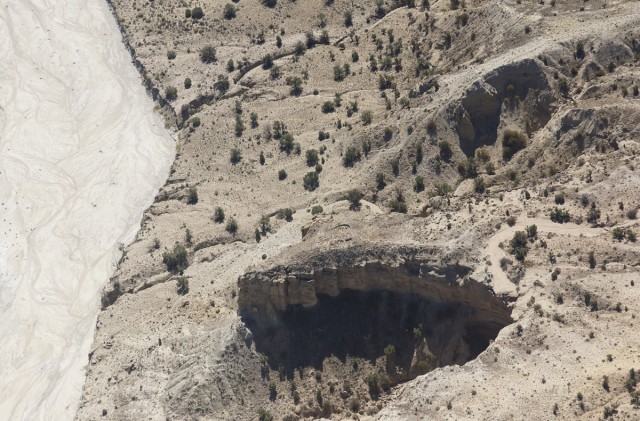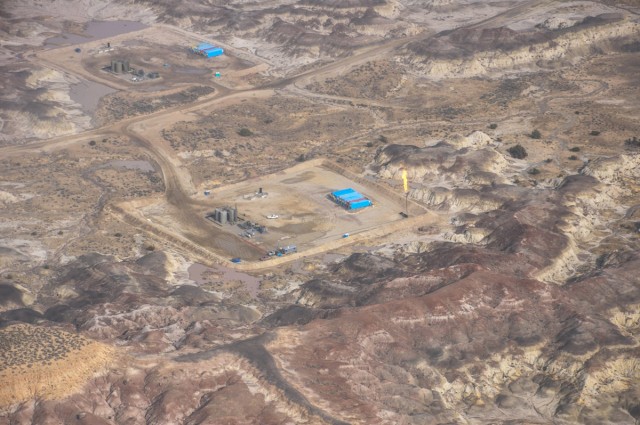- Home
- >
- Preservation Archaeology Blog
- >
- Preserving the Greater Chaco Landscape

Together with the Partnership for Responsible Business and EcoFlight, I was fortunate to be involved in two flights over the San Juan Basin and the Chacoan landscape. In October and again in November, I flew with Bruce Gordon (EcoFlight) and a number of other folks. The flights were intended to provide a bird’s eye view of the recent oil-gas developments in the area. I discussed these flights on KSJE radio; listen here.
We took off from the Farmington, New Mexico, airport, flew southeast to Kutz Canyon and Twin Angel Pueblo, then down the Great North Road over Pierre’s site and Pueblo Alto to Chaco Canyon. We then circled “Downtown Chaco,” witnessing the majesty of Pueblo Bonito, Chetro Ketl, and Casa Rinconada. These flights revealed not only the impressive footprint of the Chacoan great houses on the landscape but also the relatively pristine landscape surrounding many of the sites.

Archaeological sites within the boundaries of Chaco Culture National Historic Park are, of course, protected from all types of development. The primary area of concern currently lies just a few miles north of Chaco, outside the park boundary on lands managed by the Bureau of Land Management (BLM)’s Farmington Field Office, the Navajo Nation, and the Bureau of Indian Affairs.
In this region, drilling oil wells into the 5,000-foot-deep deposits of the Mancos Shale became profitable in early 2014. Development in this area has proceeded very rapidly in 2014, with more than 100 wells sunk into the Mancos Shale, with oil extracted via the intensive and environmentally damaging fracking process.
The San Juan Basin contains thousands of archaeological sites dating from the Paleoindian period (ca. 12,000 B.C.) to recent Navajo homesteads and camps. These sites vary in visibility from the astounding Chacoan great house structures to highly ephemeral linear road features. Clearance procedures for oil-gas permitting require archaeological surveys and, most commonly, the avoidance of resources. Such a piecemeal approach to protecting sites across the landscape does not, however, provide for adequate preservation of the larger landscape and faint features like the Chacoan roads, which are difficult to see and protect. Such sites require a greater level of consideration and protection than is typical for standard archaeological and cultural management work.
Another important issue relates to the flaring of “excess” methane gas from oil wells. This process is ongoing at many wells in the San Juan Basin, resulting in the addition of significant quantities of gas to the atmosphere. Joby Warrick of the Washington Post recently published an article on this issue.
For environmental and historic preservation groups, then, the primary concern with the explosion of oil-gas development associated with the Mancos Shale is the need to protect fragile natural and cultural resources. For many of us, this requires a new approach to permitting—one that emphasizes greater, more comprehensive planning.
Toward this end, Archaeology Southwest and many other organizations and individuals have asked BLM to change its approach to permitting wells in the Mancos Shale. BLM is currently modifying its Resource Management Plan (RMP) and Draft Environmental Impact Statement (EIS). The big push is to create larger protection zones for sites that cannot be protected through the standard “identify and avoid” model and thus protect larger tracts of the very fragile Chacoan landscape. One approach we have advocated is the use of LIDAR imaging to identify and protect ephemeral cultural resources, such as Chacoan roads.
Stay tuned as this story continues…

One thought on “Preserving the Greater Chaco Landscape”
Comments are closed.
Explore the News
Related to This
-
Location Chaco Culture National Histori...
Thank you for bringing this forward. The preservation of our nation’s irreplaceable heritage is paramount!
One blessing from the decline in oil prices is the decreasing financial viability of Mancos Shale extraction. Let us pray this respite is sufficient for us to rally our forces and convince BLM to take a more sensible and culturally viable approach to extraction permits.